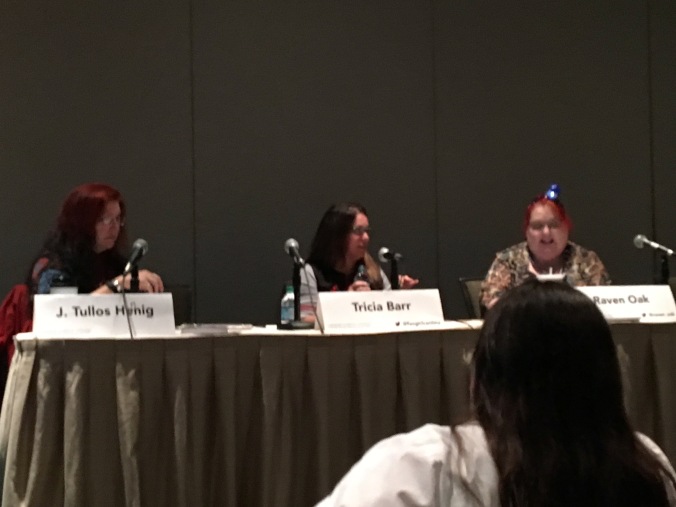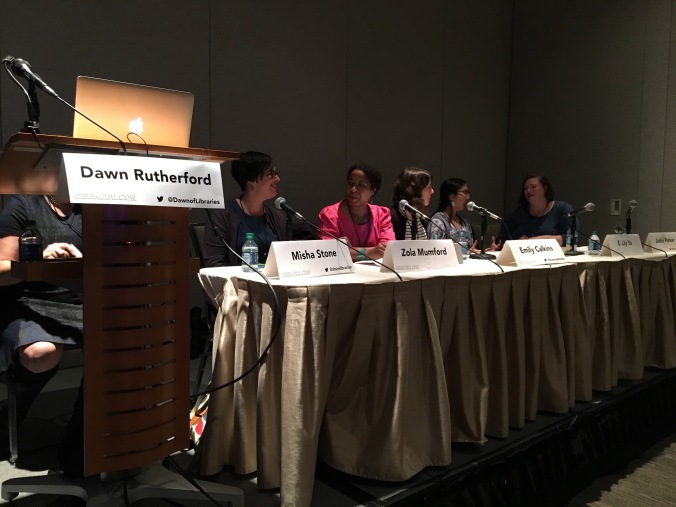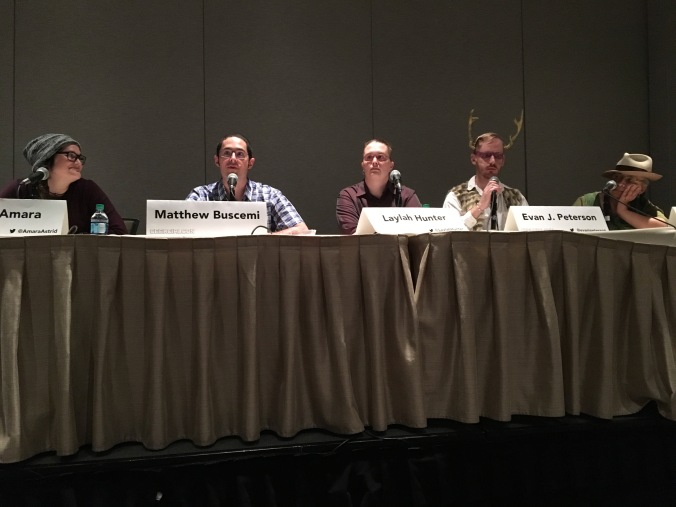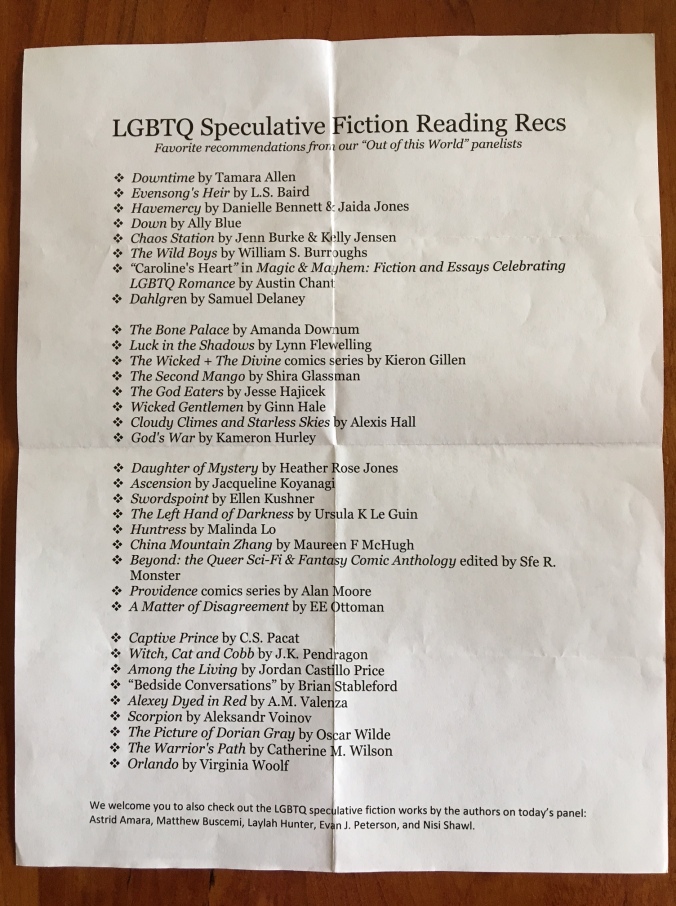Yesterday, I attended my first GeekGirlCon at The Conference Center of the Washington Convention Center in Seattle. I was interested in attending several of the panels they were offering. I ended up attending six in the twelve hours I was there. It was an intense experience. The first celebrity I ran into was none other than Artoo Detoo.
I got to the center at 8:30AM and found the doors didn’t open until 9:00. I was a little frazzled since I thought my first panel was at 9:00, but then, I found it wasn’t until 10:00, so all became right in the universe. Once the line started moving, I was inside within ten minutes. I’m glad I got there when I did. Later in the day, the line was out the door and down the block.
The first panel I attended was called “Sci-Fi Fiction Romance: Tentacles Not Required.” It explored the role of romance in Sci-Fi and Fantasy. The moderator was J. Tullow Hennig, who writes historical fantasy. Tricia Barr (Twitter @fangirlcantina), who wrote Wynde, and runs FANGirl Blog and Fangirls Going Rogue, and Raven Oak (Twitter @raven_oak), author of Amaskan’s Blood and Class-M Exile, were the panelists.

I was surprised to find there is a Sci-Fi Romance genre. There was a lively discussion around what defines Sci-Fi Romance versus Sci-Fi novels that contains relationships and romance. The Sci-Fi I have read included very little in terms of sexual relationships at all, and the Fantasy novels have included only a little more. But, apparently, there are Romance genre novels set in Sci-Fi or Fantasy realms. Like all Romance novels, the main focus is around a central love story with an emotionally satisfying—happy—ending. Sci-Fi can be defined as multi-disciplinary within “the art of the possible” (Fantasy would be “the art of the impossible”). If the writing is labeled as Sci-Fi/Fantasy, the romance should not be the focus, but just part of the plot. Speculative fiction is supposed to push boundaries, whereas Romance is supposed to be comfortable.
Falling in love, relationship building, human and emotional connections, getting the reader to root for the main characters getting together—that’s what a Romance is all about. Adding Sci-Fi or Fantasy to the mix allows a diversity factor not available in the real world. Relationships between aliens and humans are possible, allowing the author to explore how that could even be possible and what alien emotions might be like. What might be taboo in our social norms could be perfectly acceptable in a created world or universe.
Some of the recommended reading from this panel were:
Rachel Bach – The Paradox Trilogy
Claudia Gray – Star Wars: Lost Stars
Anne Bishop – The Black Jewels Trilogy
Suzanne Collins – The Hunger Games
My personal takeaway from this panel was, my writing is solidly in the Fantasy genre with character building that includes love and romance. I’m happy with this.
“Saving Sci-Fi and Fantasy: POC, Women & LGBTQ Voices Saving the Genre” was the second panel I attended. Dawn Rutherford (Twitter @DawnOfLibraries), who is Teen Service Coordinator for Sno-Isle Libraries, moderated the panel that included: Misha Stone (Twitter @ahsimlibrarian), a readers’ advisory librarian; Zola Mumford, Faculty Reference Librarian and liaison to Arts and Humanities, ESL/ABE, International Programs, and Student Services; Emily Calkins (Twitter @drawexplosions), librarian; E. Lily Yu, science fiction and fantasy writer who, in 2012, won the John W. Campbell Award for Best New Writer; and Jackie Parker (Twitter @interactiver), Readers’ Services Librarian.

This librarian-heavy panel was mostly about Sci-Fi and Fantasy genre book recommendations written by and/or about people of color, women and the LGBTQ community. Many times during the conference, I heard that talking to your librarian is an excellent way to find the types of books to read, or to have the library procure the books you want to read. Good advice.
Here are some of the books recommended by the panel:
Nisi Shawl – Everfair
Sophie (formerly Ross) Campbell – Shadoweyes
N. K. Jemisin – The Broken Earth Series (the first black author—and first woman of color —to win the Hugo for Best Novel for “The Fifth Season”)
Gene Luen Yang & Sonny Liew – The Shadow Hero
The entire list provides a plethora of reading choices. I’m going to be busy in the coming months reading some of these.
My third panel was “Adaptation, Appropriation, Influence: Using Other Cultures to Build Fictional Worlds,” moderated by Paulina Przystupa (Twitter @punuckish), a comic book collector and blog writer. The panel consisted of: Carrie McClain (Twitter @DivineBlkPearl), editor for Black Nerd Problems (Twitter @BlkNrdProblems); Tristan Tarwater (Twitter @backthatelfup), author of Hen and Chick; Karla Pacheco (Twitter @THEKarlaPacheco), who wrote the comic Dreadful Sirens with Steve LeCouilliard; and Leia Weathington (Twitter @solmaru), also a writer of comics like Deep Engines.

There was a good discussion of how one should be careful when using images and customs from other cultures. An example was Padmé Amidala in her queen regalia in Star Wars—images of actual ancient, Asian royalty were shown by comparison, and it was easy to see where George Lucas got the idea. Many examples were connected to Star Wars. A lot of the talk was with respect to Sci-Fi, where a writer should not ignore the current situation with respect to cultures, race and women, but should take care when including an updated version in their stories.
Although there was no consensus on the examples about when an author was adapting versus appropriating, it was clear the authors had published works that had offended at least some people, with the advice that, as you become more seasoned, you will likely do less damage, and, when the author is called on it, the proper response it to not get defensive, but to learn from the experience.
I’ve been thoughtful about creating the cultures in my stories. I’ll watch out for this more carefully as I edit and write more of the story. One suggestion was to involve friends in discussions about their cultures and to get feedback on your own writing—this was tempered by paying for the service, preferably monetarily, or at least, with an acknowledgement in the book.
“Ripley Loves Furiosa: Women Kicking Butt in Action, Sci-Fi & Horror” was my fourth panel, moderated by Evan J Peterson (Twitter @evanjpeterson), an author of horror who runs “SHRIEK: A Women of Horror Film Series” (Twitter @SHRIEKclass). The panel was: Grace Moore (Twitter @bonecrusherJenk), podcaster and writer; Laura Lucas (Twitter @LinesOfForce), a writer and an editor at Minor Arcana Press; and Katie Tippie.

The panelists came to a general consensus that women as either the hero or the villain are generally either hypersexual or asexual. In general, women characters in these genres are passive while waiting to be rescued by the active male protagonist who takes control of the situation. There were many examples of women in both types of roles, including Dr. Ellie Arroway (Jodie Foster) in Contact, the women in the Thor films, and The Bride (Uma Thurman) in Kill Bill. They also talked about the brutality and hyper-sexualization of women in Game of Thrones.
The panel went on to suggest some examples of strong women characters who took charge—Ellen Ripley (Sigourney Weaver) in Alien; Imperator Furiosa (Charlize Theron) in Mad Max: Fury Road; and Suzy Hendrix (Audrey Hepburn) in Wait until Dark. There were even characters from two Netflix shows: Eleven (Millie Bobby Brown) from Stranger Things and Maddie (Kate Siegel) in Hush.
These are good role models when creating women characters. I’ll use some of their qualities when fleshing out my primary woman warrior, Gillan.
Evan J Peterson was also in the next panel I attended, “Out of This World Exploring Awesomeness of LGBTQIA in SciFi,” although as a panelist for this one. It was moderated by Tracy Timmons-Gray (Twitter @timmonsgray), Community and Program Senior Manager of Collective Impact (Twitter @CIForumTweets). The rest of the panel was filled out with: Astrid Amara (Twitter @AstridAmara), author of gay science fiction, fantasy, and contemporary fiction; Matthew Buscemi, author of science fiction and fantasy; Laylah Hunter (Twitter @LaylahHunter), writer of queer speculative fiction, erotica, and romance; Nisi Shawl, author of steampunk and speculative fiction.

It was interesting to hear the different viewpoints of the panelists as they talked about how to write queer characters into your writing—call it out up front, or just let it happen naturally as part of the story. It never occurred to me to call out the fact that some of the characters in my stories have relationships with other characters of the same sex, or of both sexes—it’s just not part of their character developments, not a major focus of the story.
Apparently, the big publishers are not very queer friendly, so going to a small publisher might be the right move for an author who wants hard copies. That might be changing as novels and fictional media in general begin to include more queer characters. Labeling the book as one genre is also an issue when publishing hard copies—is it a queer novel or is it Sci-Fi? Self-publishing mitigates this with the use of multiple genre tags to promote books to different audiences. Because of this, in places like GoodReads, it is possible to narrow down a selection books considerably to be a cross-over of several genres.
This panel had a long list of recommended LGBTQ Speculative Fiction that included:
Tamara Allen – Downtime
Amanda Downum – The Bone Palace
Heather Rose Jones – Daughter of Mystery
C.S. Pacat – Captive Prince
Here’s the full list:

I think I could read for a year with all the recommendations at the panels I attended.
My final panel of the day wasn’t until 7:30 PM. It was “Queering the Apocalyse.” It dove into portraying queer and other minorities in dystopian future Sci-Fi fiction. The moderator was Sarah Mirk (Twitter @SarahMirk), who is the Online Editor of , host of feminist podcast Popaganda, author of Sex from Scratch. The panel consisted of: Zan from Northwest Press, writer of queer comics; Joamette Gil (Twitter @JoametteGil), Queer Afro-Cuban Cartoonist and Publisher/Editor at ; and Tristan J Tarwater, who was also at the “Saving Sci-Fi and Fantasy: POC, Women & LGBTQ Voices Saving the Genre” earlier in the day.

Dystopian futures are often written devoid of queer and POC characters. They sometimes completely ignore the racial and other societal tensions that exist today, without any explanation. The panel agreed these things need to be addressed—to talk about the future, a writer needs to accept and confront the present, and explain how we got from here to there.
Even when the stories do include minorities, it is often with hollow characters that are there to satisfy some need of the straight, white (usually male) protagonist. I heard complaints all day about how, if a queer or POC character is introduced, that character will almost inevitably die or meet some other brutality—they’re not the main protagonists. Tarwater confessed, as soon as the characters are introduced, she gets anxious about them, and rightfully so.
I’ll give this topic careful consideration when I move on to my next big story (I’ve already done a little writing on it) about a dystopian future. The panel brought up lots of issues to be aware of.
Overall, I was greatly pleased by all of the panels I attended, and GeekGirlCon in general. It was professionally run by a group of volunteers. The crowd was polite, and very female. My experience was all good. There were ample red-shirted volunteers available to answer question or guide attendees to events. Besides the panels, I visited the exhibitors’ hall, which had an impressive number of varied booths. I also experienced VR for the first time in the VR Maker Dome (Twitter ). I got to play Space Pirate Trainer! It was awesome!
I’m definitely planning to attend GeekGirlCon17.
Copyright ©2014-16 Ramona Ridgewell. All rights reserved.










